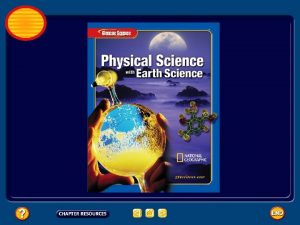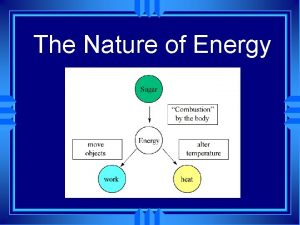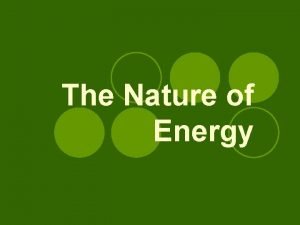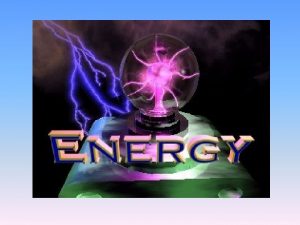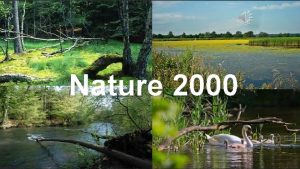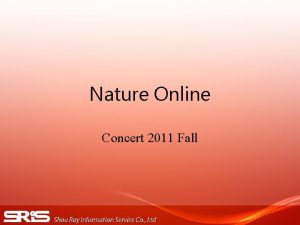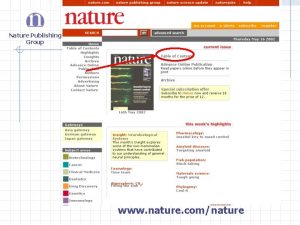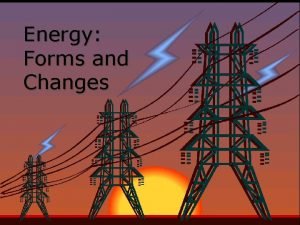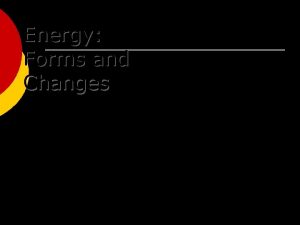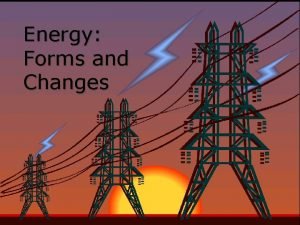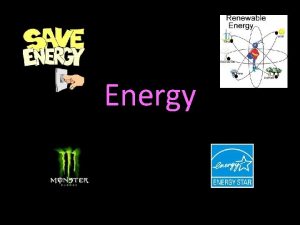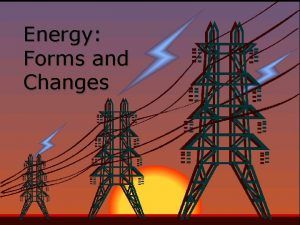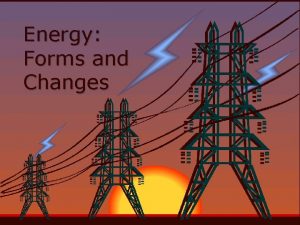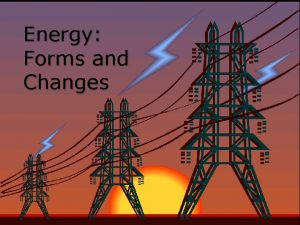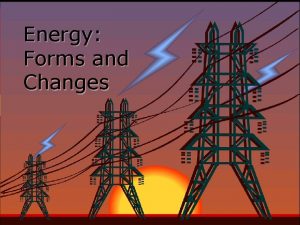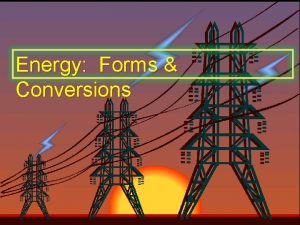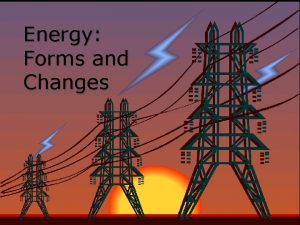The Nature of Energy The Nature of Energy




















































- Slides: 52

The Nature of Energy

The Nature of Energy u Energy is the ability to do work or produce heat. u It exists in two basic forms, potential energy and kinetic energy.

The Nature of Energy u Kinetic energy is energy of motion. u Kinetic energy increases as the temperature of molecules goes up.

The Nature of Energy u Comparing any two samples, the one with the higher temperature has the higher kinetic energy.

The Nature of Energy u Temperature is a measure of an object’s average kinetic energy. u The unit for temperature commonly used by scientists is degrees Celsius or Kelvin.

The Nature of Energy u The potential energy of a substance depends upon its composition: the type of atoms in the substance, the number and type of chemical bonds joining the atoms, and the particular way the atoms are arranged.

The Nature of Energy u Chemical potential energy is stored in gasoline, wood, food, etc.

Law of Conservation of Energy u The law of conservation of energy states that in any chemical reaction or physical process, energy can be converted from one form to another, but it is neither created nor destroyed.

The Nature of Energy u Chemical systems contain both kinetic energy and potential energy. u Energy (kinetic and potential) of the particles of a substance changes when heated, cooled, or changing phase.

The Nature of Energy u As you consider the phases - solid, liquid, gas – this is in order of increasing potential energy. u Solids have the least potential energy. Liquids have a moderate amount of potential energy. Gases will have the most potential energy.

Heat u Heat, which is represented by the symbol q, is energy that is in the process of flowing from a warmer object to a cooler object. u The standard unit of heat and energy is the joule (J).

Heat u Heat involves a transfer of energy between 2 objects due to a temperature difference.

Heat flows from “hot to cold. ”

Law of Conservation of Energy u When the warmer object loses heat, its temperature decreases and q is negative. u When the cooler object absorbs heat, its temperature rises and q is positive.

PHASE CHANGES

Phase Changes u. A material will change from one state or phase to another at specific combinations of temperature and surrounding pressure. u Typically, the pressure is atmospheric pressure, so temperature is the determining factor to the change in state in those cases.

? ? Vaporization Solid Liquid Gas Condensation ? ?

Condensation and Vaporization

Vaporization u Vaporization is the process by which a liquid changes into a gas or vapor. u Vaporization is an endothermic process – the liquid absorbs heat.

Evaporization u When vaporization occurs only at the surface of an uncontained liquid (no lid on the container), the process is called evaporation.

Endothermic u Endothermic • Absorbs heat • Would feel cold if you were to touch it • Pulls in heat from its surroundings – such as your hand, and converts it to chemical potential energy

Condensation u Condensation is the process by which a gas or vapor becomes a liquid. It is the reverse of vaporization. u Condensation is exothermic – heat is released.

Endothermic u Exothermic • Releases heat • Would feel hot if you were to touch it • Release chemical potential energy and you would perceive it as heat

Energy During Vaporization & Condensation u Vaporization results in an increase in potential energy. u Condensation results in a decrease in potential energy. u Kinetic energy remains constant during vaporization and condensation.

Dynamic Equilibrium u In a closed system, the rate of vaporization can equal the rate of condensation. u When the rates are equal the system is said to be in dynamic equilibrium.

Dynamic Equilibrium u Molecules are constantly changing phase - “Dynamic” u The total amount of liquid and vapor remains constant - “Equilibrium”

Vapor Pressure u Vapor pressure is the pressure exerted by a vapor over a liquid.

Vapor Pressure u As temperature increases, water molecules gain kinetic energy and vapor pressure increases.

Vapor Pressure u Vapor pressure does not change with surface area.

Vapor Pressure u Vapor pressure for a liquid is lowered when sugar or salt is dissolved in the liquid.

Dynamic Equilibrium u http: //www. kentchemistry. com/links/ Matter/Vapor. Pressure. htm

Boiling u When the vapor pressure of a liquid equals atmospheric pressure, the liquid has reached its boiling point, which is 100°C for water at sea level. u Standard atmospheric pressure equals 1 atm.

Boiling u At this point, molecules throughout the liquid have the energy to enter the gas or vapor phase. u The temperature of a liquid can never rise above its boiling point.

Melting ? ? Solid Liquid Freezing ? ? Gas

Melting and Freezing

Melting u The melting of a solid occurs when the forces holding the particles together are broken and the solid becomes a liquid. u Melting is an endothermic process – the solid absorbs heat.

Freezing u Freezing occurs when a liquid becomes a crystalline solid. u Freezing is an exothermic process – the liquid releases heat. u The freezing point is the same as the melting point.

Energy During Melting & Freezing u Melting results in an increase in potential energy. u Freezing results in a decrease in potential energy. u Kinetic energy remains constant during melting and freezing.

? ? Sublimation Solid Liquid Deposition ? ? Gas

Sublimation and Deposition

Sublimation u The process by which a solid changes directly into a gas without first becoming a liquid is called sublimation. u Solid air fresheners and dry ice are examples of solids that sublime. u Sublimation is endothermic.

Deposition u When a substance changes from a gas or vapor directly into a solid without first becoming a liquid, the process is called deposition. u Deposition is the reverse of sublimation.

Deposition u Frost is an example of water deposition. u Deposition is exothermic.

Energy During Sublimation & Deposition u Sublimation results in an increase in potential energy. u Deposition results in a decrease in potential energy. u Kinetic energy remains constant during sublimation and deposition.

Phase Changes of Water and Energy

Phase Changes of Water and Energy

Condensation Freezing. Deposition Sublimation Vaporization Melting Solid Liquid Gas

Question Classify the following phase change. 1. dry ice (solid carbon dioxide) to carbon dioxide gas sublimation

Question Classify the following phase change. 2. ice to liquid water melting

Question Classify the following phase change. 3. liquid water to ice freezing

Question Classify the following phase change. 4. water vapor to liquid water condensation

 Energy energy transfer and general energy analysis
Energy energy transfer and general energy analysis Energy energy transfer and general energy analysis
Energy energy transfer and general energy analysis Nature and nature's law lay hid in night
Nature and nature's law lay hid in night Determinace lidské psychiky
Determinace lidské psychiky Hình ảnh bộ gõ cơ thể búng tay
Hình ảnh bộ gõ cơ thể búng tay Frameset trong html5
Frameset trong html5 Bổ thể
Bổ thể Tỉ lệ cơ thể trẻ em
Tỉ lệ cơ thể trẻ em Chó sói
Chó sói Glasgow thang điểm
Glasgow thang điểm Chúa yêu trần thế
Chúa yêu trần thế Các môn thể thao bắt đầu bằng tiếng bóng
Các môn thể thao bắt đầu bằng tiếng bóng Thế nào là hệ số cao nhất
Thế nào là hệ số cao nhất Các châu lục và đại dương trên thế giới
Các châu lục và đại dương trên thế giới Công thức tiính động năng
Công thức tiính động năng Trời xanh đây là của chúng ta thể thơ
Trời xanh đây là của chúng ta thể thơ Cách giải mật thư tọa độ
Cách giải mật thư tọa độ Phép trừ bù
Phép trừ bù Phản ứng thế ankan
Phản ứng thế ankan Các châu lục và đại dương trên thế giới
Các châu lục và đại dương trên thế giới Thể thơ truyền thống
Thể thơ truyền thống Quá trình desamine hóa có thể tạo ra
Quá trình desamine hóa có thể tạo ra Một số thể thơ truyền thống
Một số thể thơ truyền thống Bàn tay mà dây bẩn
Bàn tay mà dây bẩn Vẽ hình chiếu vuông góc của vật thể sau
Vẽ hình chiếu vuông góc của vật thể sau Thế nào là sự mỏi cơ
Thế nào là sự mỏi cơ đặc điểm cơ thể của người tối cổ
đặc điểm cơ thể của người tối cổ Ví dụ về giọng cùng tên
Ví dụ về giọng cùng tên Vẽ hình chiếu đứng bằng cạnh của vật thể
Vẽ hình chiếu đứng bằng cạnh của vật thể Fecboak
Fecboak Thẻ vin
Thẻ vin đại từ thay thế
đại từ thay thế điện thế nghỉ
điện thế nghỉ Tư thế ngồi viết
Tư thế ngồi viết Diễn thế sinh thái là
Diễn thế sinh thái là Các loại đột biến cấu trúc nhiễm sắc thể
Các loại đột biến cấu trúc nhiễm sắc thể Số nguyên tố là số gì
Số nguyên tố là số gì Tư thế ngồi viết
Tư thế ngồi viết Lời thề hippocrates
Lời thề hippocrates Thiếu nhi thế giới liên hoan
Thiếu nhi thế giới liên hoan ưu thế lai là gì
ưu thế lai là gì Sự nuôi và dạy con của hổ
Sự nuôi và dạy con của hổ Khi nào hổ con có thể sống độc lập
Khi nào hổ con có thể sống độc lập Hệ hô hấp
Hệ hô hấp Từ ngữ thể hiện lòng nhân hậu
Từ ngữ thể hiện lòng nhân hậu Thế nào là mạng điện lắp đặt kiểu nổi
Thế nào là mạng điện lắp đặt kiểu nổi Section 1 what is energy answer key
Section 1 what is energy answer key What is the nature of energy
What is the nature of energy Chapter 4 section 1 the nature of energy worksheet answers
Chapter 4 section 1 the nature of energy worksheet answers What is sublimation give examples
What is sublimation give examples Energy stored in a candy bar is an example of
Energy stored in a candy bar is an example of The nature of energy section 1
The nature of energy section 1 Chemical potential energy images
Chemical potential energy images














































